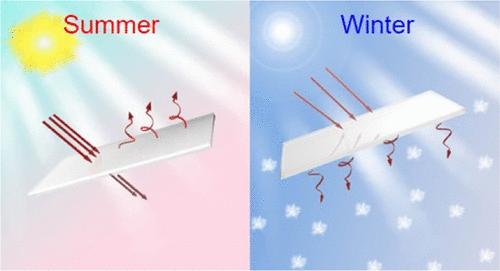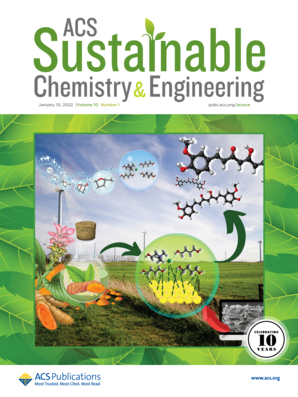Scalable Fabrication of Thermochromic Smart Windows for Broadening Temperature Ranges and Their Coupled Thermoelectric Power Generation
IF 7.1
1区 化学
Q1 CHEMISTRY, MULTIDISCIPLINARY
引用次数: 0
Abstract
Thermochromic materials exhibit variable optical properties in response to ambient temperature changes and are promising for the development of smart windows aimed at reducing energy consumption in buildings. However, scaling up the thermochromic materials-based smart window with a broad color-changing range remains a significant challenge for practical engineering applications. In this study, we present a series of PNIPAm-based thermochromic hydrogels with controllable discoloration temperatures ranging from 24 to 43 °C, achieved by regulating the swelling–dissolution transition. These materials demonstrate a high solar modulation capacity (>81%), excellent transmittance (>83%), and low haze value (<9.87%). Two strategies for the integration of smart windows are provided, and their effectiveness in reducing energy consumption is verified. Practical application tests conducted in Shanghai during the summer show that using smart windows can reduce indoor temperatures by up to 13 °C. Simulation results further indicate that these smart windows offer significant energy-saving benefits in various cities, particularly those with high daily energy consumption and poor thermal insulation. Additionally, the thermochromic hydrogel is coupled with a thermoelectric hydrogel, utilizing the residual heat from the glass surface to generate electricity, thus powering small electrical appliances.

用于拓宽温度范围的热致变色智能窗口的可扩展制造及其耦合热电发电
热致变色材料具有随环境温度变化而变化的光学特性,有望用于开发旨在降低建筑物能耗的智能窗户。然而,扩大基于热致变色材料的智能窗户的变色范围,对于实际工程应用来说仍然是一项重大挑战。在本研究中,我们展示了一系列基于 PNIPAm 的热致变色水凝胶,这些水凝胶通过调节溶胀-溶解转变实现了 24 至 43 ℃ 的可控变色温度。这些材料具有较高的太阳光调节能力(81%)、出色的透光率(83%)和较低的雾度值(9.87%)。报告提供了两种集成智能窗的策略,并验证了它们在降低能耗方面的有效性。夏季在上海进行的实际应用测试表明,使用智能窗可以降低室内温度达 13 °C。模拟结果进一步表明,这些智能窗户在不同城市,尤其是日常能耗高、隔热性能差的城市,具有显著的节能效果。此外,热致变色水凝胶还与热电水凝胶相结合,利用玻璃表面的余热发电,从而为小型电器提供电力。
本文章由计算机程序翻译,如有差异,请以英文原文为准。
求助全文
约1分钟内获得全文
求助全文
来源期刊

ACS Sustainable Chemistry & Engineering
CHEMISTRY, MULTIDISCIPLINARY-ENGINEERING, CHEMICAL
CiteScore
13.80
自引率
4.80%
发文量
1470
审稿时长
1.7 months
期刊介绍:
ACS Sustainable Chemistry & Engineering is a prestigious weekly peer-reviewed scientific journal published by the American Chemical Society. Dedicated to advancing the principles of green chemistry and green engineering, it covers a wide array of research topics including green chemistry, green engineering, biomass, alternative energy, and life cycle assessment.
The journal welcomes submissions in various formats, including Letters, Articles, Features, and Perspectives (Reviews), that address the challenges of sustainability in the chemical enterprise and contribute to the advancement of sustainable practices. Join us in shaping the future of sustainable chemistry and engineering.
文献相关原料
公司名称
产品信息
阿拉丁
N,N-Dimethylacetoacetamide
阿拉丁
glycerol (Gly)
阿拉丁
K3[Fe(CN)6]
阿拉丁
K4[Fe(CN)6]·3H2O
阿拉丁
gelatin
 求助内容:
求助内容: 应助结果提醒方式:
应助结果提醒方式:


